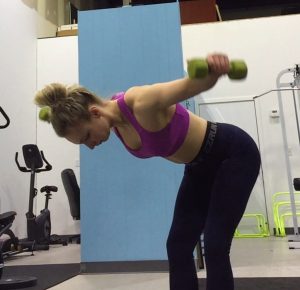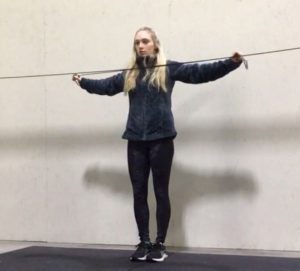
11 of the Best Rear Delt Exercises
Working your rear delts can help improve your posture, prevent or reduce shoulder pain, improve strength and improve your physique. While this muscle group is oft forgotten, training your rear delts can pay dividends. In this post, we will discuss eleven of the best rear delt exercises to add to your training program.
Dumbbell Rear Delt Fly
The dumbbell rear delt fly is one of the best rear delt exercises to add to your program.
You can do this exercise in a bent over position, or in a chest supported position on a bench. Hold light weights and place them in line with your shoulders, with palms facing each other. Keeping your arms in line with your shoulders, lift your arms until your hands are level with your shoulders. Pause one count and then return to the start position.
Try two to four sets of 12 to 20 reps of this exercise towards the end of your upper body workouts.

Cable Rear Delt Fly
The Cable Rear Delt Fly is another one of the best rear delt exercises. However, this exercise has a slightly different strength curve than the dumbbell variation. In addition, you can do this exercise in a completely upright position, reducing any stress on your lower back.
To perform this exercise, place the handles of a cable pulley system at shoulder height. Next, position the right handle in your left hand, and the left handle in your right hand. Keeping your arms mostly straight, pull the handles apart to form an “X” formation until your arms are straight and your arms are out to your sides. Pause one count and then return your hands in front of your shoulders. Keep your arms straight throughout to keep the tension on your upper back and rear deltoids.
You can try two to four sets of 10 to 20 reps of this exercise.

Face Pull
Have you tried the face pull before? This movement will strengthen your rear delts and upper back. Depending on how you perform it, you can also do a great job strengthening your rotator cuff muscles.
To perform this move, set up a rope attachment at the top of a cable pulley system. Put one hand on either end of the rope in an underhand grip. Next, step back to remove the weight from the stack and place one foot in front of the other. You can also do this exercise while seated on the floor.
Pull back and apart on the rope, forming a “double biceps pose” with elbows bent to 90 degrees. Pause one count and then return to the start position.
You can try two to three sets of 8 to 20 reps of the face pull.
Dumbbell Bent Over Row
The dumbbell bent over row is a compound exercise that trains the rhomboids, lats, teres minor and major, traps, rotator cuff muscles and rear deltoids.
To perform this exercise, hold a weight in one or both hands. Perform a hip hinge and let arms hang down underneath your shoulders. Pull your weights back, bend your arms to roughly 120 degrees and pull your shoulders back, squeezing your back at the top. Pause one count and then return to start.
Try 2-4 sets of 6-12 reps of this exercise.
Band Pull Apart
Many people feel the band pull apart is an easy exercise that is only suitable for beginners. In truth, this exercise is suitable for all fitness levels. Additionally, this movement can help you build strong rear deltoids and improve your posture.
To perform band pull aparts, hold a band at shoulder height with your arms straight. Pull on the band until it touches your chest, keeping your arms straight. Pause when your hands are in line with your shoulders, and then return back to the start position.
Try two to three sets of 10 to 20 reps on this exercise. Alternatively, you could try performing one set of ten reps daily to improve your posture.
Y,T,I,W
The Y/T/I/W movement series (also sometimes referred to as “Blackburns”)can help strengthen your rear deltoids and reduce or prevent shoulder pain. If you do try this movement, I recommend trying it at the beginning of your upper body workouts. This exercise can warm up your shoulders, rotator cuff and scapular stabilizers so they all fire properly during a bench press or power clean workout.
To get started, face down on a bench or on the floor. Use your arms and shoulders to make the letters Y/T/I/W. You might consider watching a video tutorial before performing this exercise.
Try one set of 5-8 reps each at the beginning of your workout. Use light weights only. Honestly, 2-3 pounds per side should suffice.
Inverted Row
The inverted row is another compound exercise that trains your back, shoulders and arms. To really focus on your rear delts, try an overhand grip and keep your elbows high and wide.
First, place a bar on a power rack at about shoulder height to start. Place your hands at shoulder width with an overhand grip. Place your feet in front of you at an incline position. Pull your chest to the bar by squeezing your back and shoulders and bending your arms. Pause one count and then return to start.
Try two to four sets of 6-12 reps with this movement. As you get stronger, place the bar closer to the floor. Placing the bar closer to the floor increases your lever length on this exercise, making it more challenging.
Seated Cable Row
The seated cable row is another great compound exercise that trains all the major muscle groups in the back, as well as the rear deltoids, biceps and forearms. This exercise does not usually aggravate shoulder pain in people with wonky shoulders.
To perform this exercise, set a close or wide grip handle at rib cage height at a cable (or at rib cage height when you sit down). Sit down on a bench with feet flat on the floor. Start with your arms extended out in front of you at rib cage height. Pull your shoulders back, then pull your handle into your rib cage by squeezing your back and biceps and bending your arms. Pause with cable at your ribs, and then return to the start position.
Try three to five sets of 6 to 12 reps of the seated cable row.
TRX Face Pull
The TRX Face pull is a similar exercise to the cable face pull with a rope attachment. However, this exercise also forces you to engage your core to keep a neutral spine and pelvic position throughout.
To perform this move, position a TRX in a secure overhead position. Next, place your hands in the TRX handles, with an overhand grip. Place your feet at an angle in front of you, with your spine neutral and arms straight. Pull your arms into the “double bicep” pose, squeezing your rear delts and upper back. Pause and hold one count at the top before returning to a straight arm position.
You can try three to four sets of six to fifteen reps on this exercise. As you get stronger, position your feet farther forward.
Lower Trap Raise
This exercise is an unsung hero for shoulder health and rear deltoid development. Like the name suggests, this movement trains the often forgotten lower traps and helps bring muscular balance between the upper and lower traps.
To do this move, position yourself face down on an incline bench, standing with your legs straight and feet straddling the bench. Next, position light weights in your hands, with palms facing each other, hands starting right underneath your shoulders. Keeping your arms straight, lift your weights up to form a “Y” shape at the top of the movement. Avoid shrugging your shoulders at the top. Make sure to pause one count at the top and then return to the start position.
Try three to four sets of eight to fifteen reps with this exercise.
Seal Row
The seal row is one final excellent movement to train your back and rear deltoids. Unlike a traditional bent over row, this movement does not require you to maintain a hip hinge position. This makes this movement really easy on your lower back.
To do this exercise, position yourself face down on a bench, with legs lying on the bench. Position weights underneath your shoulders. Row your weights towards your rib cage. Pause one count at the top, and then return back to the bottom position.
Try three to four sets of six to twelve reps with the seal row.
Final Thoughts
Training your rear delts regularly can result in significant improvements in your strength, physique and overall shoulder health.
Consider adding some of these rear delt exercises into your routine to strengthen your rear delts, improve muscular balance and prevent or reduce shoulder pain.